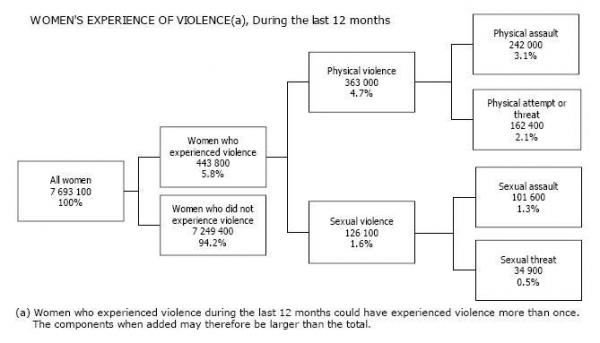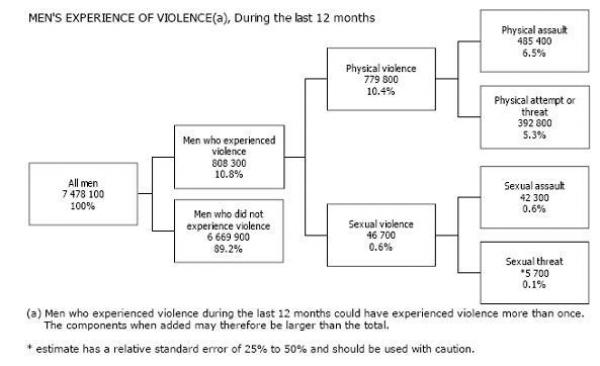Violence and the invisible sex
The Home Office claims that violence against women and girls costs £40.1 billion a year. That’s a very big claim.
It’s almost as much as is spent on the total UK defence budget (£42.1 billion), and about half the education budget (£79.9 billion). Can domestic and sexual violence against women, abhorrent as it is, really cost that much, or has the figure been inflated to justify Government policies?
These include plans to teach children about the evils of wife-beating from the age of five, under the rubric of “educating children and young people about healthy, non-violent relationships”. Teachers will also be given guidance on tackling “gender bullying”.
The £40.1 billion figure was cited recently in Saving Lives, Reducing Harm, Protecting the Public, a Home Office publication, which gave as its source the Pre-Budget Report and Comprehensive Spending Review for 2007. So the authority for the figure rests on another Government document.
The Home Office has carried out research to discover the true figure. One estimate, published in 2005 in Economic and Social Costs of Crime against Individuals and Households, found that the total burden of crime in 2003-04 was £36.2 billion. Sexual offences and violence against the person together represented 60 per cent of this figure – just under £22 billion. That includes offences against men as well as women.
In September 2004, the Women and Equality Unit published a study by Sylvia Walby of the University of Leeds that calculated the cost of domestic violence, including rape, at £5.7 billion: made up of £3.1 billion for legal, court, NHS, social services and housing costs of £3.1 billion, and loss to the economy of £2.7 billion.
That is much lower than either £40.1 billion or £22 billion. The difference is accounted for by human and emotional costs, which are reckoned by Dr Walby as £104,300 for each serious assault or rape. The figure is arbitrary, and open to argument. However, if we accept it as reasonable, the total costs of domestic violence and rape against women, on her reckoning, totted up to £13.9 billion. Puzzlingly, in these tables, the costs of rapes appear to be counted twice, once under rape and assault by penetration (37,000 cases) and once as rape (28,000 cases). Discount this and the total would be £2.9 billion lower.
So where does the £40.1 billion figure come from? Whatever its source, it now forms part of the “narrative” of violent crime - to use a favourite New Labour word - as if constant repetition would make it true.
The second part of the narrative is that women are uniquely vulnerable to violence, and that it doesn’t happen to men, unless they are the type to get involved in fights at the pub or outside football grounds. Harriet Harman’s wife-beating lessons do not include violence against men. It doesn’t happen, apparently.
So firmly entrenched is this belief that funding for men’s and fathers’ organisations is routinely turned down. The Charity Commissioners even refused in 2000 to register a men’s and fathers' organisation on the grounds it was against the law to discriminate against women whereas it was still not illegal to discriminate against men.
For ten years men’s action groups and lobbyists have sought the same support for male victims of domestic violence that has been afforded women via Women’s Aid and Refuge. They have consistently been refused, on the grounds that men are a minority of domestic violence victims (10 per cent or less) and therefore didn’t qualify or justify a diversion of funds. This attitude remains unchanged, in spite of the Government finally accepting British Crime Survey figures which have been telling them for years that a significantly large minority of victims, in the region of 30 per cent, are male.
Crime figures are notoriously tricky, so perhaps ministers simply don’t believe what their own figures tell them. Let’s look overseas.
In 2006 the Australian Government published In Matters of Personal Safety, a report recording the levels of violence experienced by men and women. The survey defined violence as including “any incident involving the occurrence, attempt or threat of either physical or sexual assault”. It concluded that 5.8 per cent of Australian women experienced violence so defined in the 12 months prior to the survey, as did 10.8 per cent of men. The figures are summarised in the two flow diagrams below:


The source for these charts is Personal Safety Survey 2005, Australian Bureau of Statistics (ABS). available here.
It quickly becomes apparent that 94 per cent of Australian women had not experienced violence, in stark contrast to the claim often made that “1 in 4” women are victims of it. The figure for women is in line with the Home Office Survey of 1999 (HORS 191), which put the proportion of women in England & Wales who had experienced violence at 4.2 per cent.
Over a ten-year period (1996-2005) the Australian data shows just over half of all men experienced some form of violence compared with only 40 per cent of women. If violence is an expression of the human condition, we can expect similar patterns in Britain, which makes the attitudes of successive ministers look absurd.
Is there any chance of a change? Or will we, in the next ten years, continue to see men’s organisations routinely and repeatedly refused funding for projects identical to those where women's organisations successfully apply? Ministers minds are made up: please don’t confuse them with the facts.




Gilbert Hall (not verified) wrote,
Wed, 16/09/2009 - 13:43
There's an idea, almost an ideology, around that it's important to only admit that women and girls suffer violence and that violence against men or boys should be ignored. Amnesty International has run a "Stop Violence Against Women" campaign for several years which is full of this nonsense. Its current website contains one of their favourite slogans: "Women and girls suffer disproportionately from violence". From the Australian research you quote, it seems that, in Australia at at least, the opposite it the case.
Having been quite involved with Amnesty over the last 30 years, I have tried to make them see sense. They're very nice about talking to me about it but they don't seem open to reason. Several letters have been printed in the UK Amnesty members' magazine questioning the "Stop Violence Against Women" campaign but each is followed by at least two very angry letters in the following edition condemning anyone who dares to discuss the issue.
Robert Whiston (not verified) wrote,
Thu, 01/10/2009 - 00:54
Dear Gilbert,
Your last remark hits the nail on the head. Intimidation by angry letters, open hostility or threats is usually sufficient to shut up opposition and free thinking minds.
The Quakers at Friends House, Euston Road, were also seized of political correctness in the 1990s. Their library refused to stock a book by Dr Patricia Morgan that called into question whether single mothers were doing so good a job s eh public were led to believe (“Farewell to the Family ?”. IEA, 1995). Copies were presented but were either rejected by management or never loaned out to members.
The antics at Amnesty have not gone unnoticed. The same criticisms can be made of the American VAWA legislation which has cost billions and for no real tangible result.
With regard Australia, I try to make the point, or imply, that dealing with a doorstep problem leads to blinkered thinking. Taking an overseas example should free minds from this curtain effect. In truth, the numbers are the in the same proportion here, as in France, as in Australia – its just that each nations prefers not to think too deeply about them.
I hope this helps.
Yours truly,
Robert Whiston
Sara (not verified) wrote,
Fri, 09/10/2009 - 21:41
As a woman, I find all this disgusting and awful. I am ashamed.
Violence is violence, no matter what your gender, and both male and female victims need help.
Time for other women to wake up and speak out before all these ridicolous laws and education tactics put our little boys in jeapordy!
Robert Whiston (not verified) wrote,
Thu, 22/10/2009 - 11:04
Dear Sara, Thank you for you comments. I wish more women would get involved in this sort of thing -it seems to be the fashion for politicians to listen to women's views but not men's. All women have fathers, brothers and sons who could suffer by being excluded from policy matters. These and other points (e.g. violence towards ethnic minority fathers) have been made to Baroness Scotland for several years but to no avail. Baroness Scotland always maintained that male victims were such a small minority that they didn't merit monetary support. News of her illegal activity in recent days while Attorney General and not feeling compelled to resign therefore comes as no surprise.
Anonymous (not verified) wrote,
Wed, 17/03/2010 - 23:56
I think plenty of women find this wrong. Sara is hardly unique - although I'm very glad she took the time to write here.
My experience of female opinion on this matter is that the girls just out of school that I went to university with shouted loudest about "No man may do this that etc" with the implied idea that violence against women is worse than that against men. By contrast mothers with sons tend to see things in a rather different way.
People were afraid to argue with the loudmouths then and it is the same dynamic now. Today the loudmouths are the BBC and - it seems - amnesty international, among others. Mention that there is any inequality of the law or injustice affecting men and they go strangely silent.
It is as often men as women, infuriatingly, who ridicule such an idea or say it is a non-issue. I find the stupidity on display pretty much unforgiveable
I think another part of the story is that a similar organisation and cooperation may be needed amongst men (as feminists achieved) if we are to get anyone to seriously address matters such as discrimination against men, paternity leave/pay etc or soon we;ll have replaced one set of inequalities with another,
The strongest argument in women's movements had equality at their centre. I do wonder if anyone cares about equality at all, or they think it works just one way round. It's as silly as that
Anonymous (not verified) wrote,
Thu, 18/03/2010 - 00:06
I am so glad you're doing these articles. There is something wrong in some common attitudes in Britain towards men today.
Unfortunately few of the mens/fathers organisaions are as balanced, thoughtful and rational as they need to be to win arguments like this (which shouldn't be hard to win but...) You're providing some sense and I plan to send people this way to see the arguments presented here
MelindaLV (not verified) wrote,
Tue, 07/09/2010 - 18:19
To reduce domestic and sex violence, both men and women have to be more open. There were times when we're conservative, now the era is much different. It's just like how men in Great Britain, America, Japan, China, Africa, and others act and think differently towards having sex. Some are wilder, some have more respects, some are rude, etc you know.. London Escorts
Anonymous (not verified) wrote,
Wed, 20/10/2010 - 15:50
I think a very good post Tjene Penge